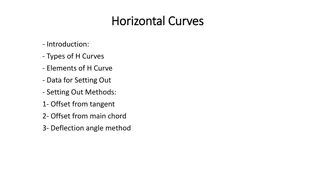Understanding Hysteresis Curves and Magnetic Materials in Electromagnetism
Hysteresis curves play a crucial role in understanding the properties of ferromagnetic substances like soft iron and steel. The differences in retentivity, coercive force, permeability, and susceptibility between these materials impact their performance in electromagnets and transformer cores. The choice of magnetic materials, such as steel for permanent magnets and vicalloy for high coercivity, is essential for various applications in electromagnetism. Soft iron stands out as an ideal material for electromagnets due to its low hysteresis loss. Overall, selecting the right material based on hysteresis characteristics is vital for efficient operation in electromagnetic devices.
Download Presentation

Please find below an Image/Link to download the presentation.
The content on the website is provided AS IS for your information and personal use only. It may not be sold, licensed, or shared on other websites without obtaining consent from the author. Download presentation by click this link. If you encounter any issues during the download, it is possible that the publisher has removed the file from their server.
E N D
Presentation Transcript
The importance of hysteresis curves
The properties ferromagnetic substance obtained from the size and shape hysteresis loop. Fig. shows hysteresis loops for soft iron and steel. magnetic of a can be of the the
The retentivity of soft iron (OC) is greater than that of steel (OC'). i.e., soft iron retains more magnetism than steel, when the magnetizing force is totally removed. The coercive force for soft iron (OD) is smaller than that for steel (OD ). ie. iron is more readily demagnetised than steel.
the permeability = (BIH) for soft iron is greater than that for steel. The susceptibility = (MIH) for soft iron is greater than that for steel. The area of the B-H loop for steel is much larger than that for soft iron. Thus the energy loss per unit volume per cycle of magnetisation is greater for steel than that for soft iron.
Choice of Magnetic materials. Permanent Magnets. Materials used for making magnets are never taken through a cycle. So hysteresis loss is a minor consideration in these cases. These materials should have high retentivity and high coercivity. So steel is a suitable material for permanent magnets. .
Recently a number of alloys, having large values of coercivity have been developed for the purpose of construction of permanent magnets. The very suitable alloy of highest coercivity is named as vicalloy (vanadium, iron and alloy cobalt).
Electro-magnets The material for the cores of electromagnets should have maximum flux density with comparatively small magnetising field and low hysteresis loss. Soft-iron is an electromagnets. ideal material for
Transformer cores Materials diaphragms and chokes etc.. (which are meant for obtaining high magnetic flux) are frequently subjected to many cycles of magnetisation in one second. So the material selected for the purpose must be associated with high magnetic induction and low hysteresis loss. for transformer cores, telephone
Soft-iron is better than steel for these purposes. By alloying soft-iron transformer steel is produced. It has a higher initial permeability and is an ideal material for cores of transformers. Alloys of iron and nickel, called permalloys have also very large initial permeabilities with 4% silicon,
Ferrites Their very high. Ferrites are made by sintering consisting of a mixture of ferric oxide and the oxides of other metals like lithium, nickel and manganese. permeability is powders
Their hysteresis loop is almost rectangular [Fig.) which enables these to be used for memory circuit in computers. These have a high electrical resistivity unlike the ferromagnetic materials which are very good conductors. So ferrites are widely used in the manufacture of components for Radio and electrical communication























